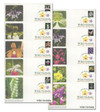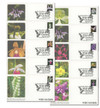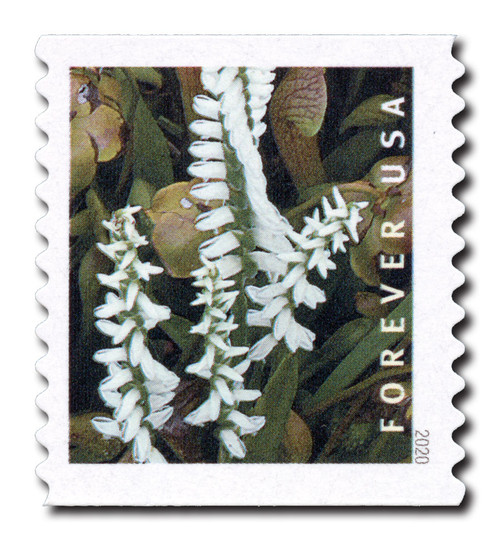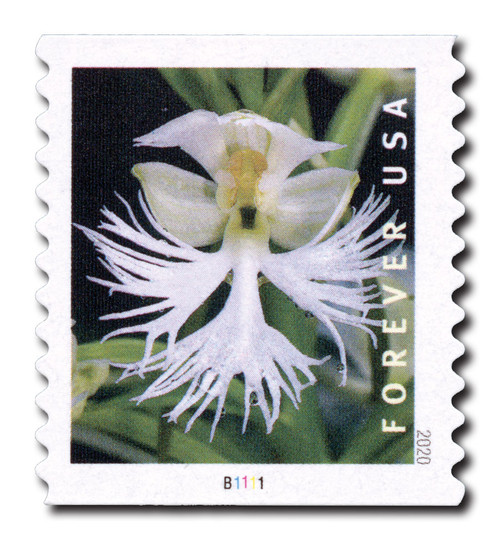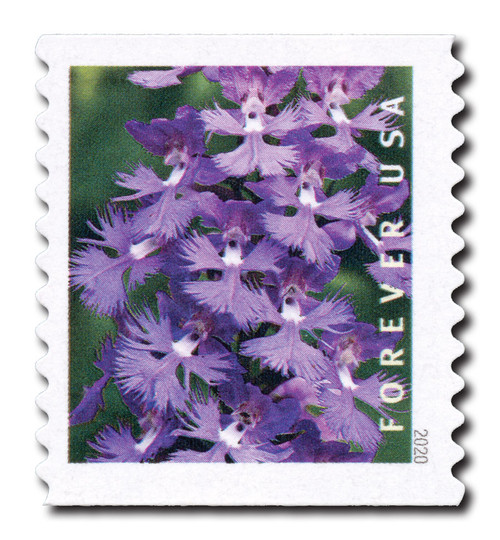
# 5435-44 - 2020 First Class Forever Stamp - Wild Orchids (coil)
US #5435-44
2020 Wild Orchids (Coil)
- Pictures nine orchid species native to the United States (one species shown twice)
Stamp Category: Definitive
Value: 55¢ First Class Mail Rate (Forever)
First Day of Issue: February 21, 2020
First Day City: Coral Gables, Florida
Quantity Issued: 15,000,000 OR 50,000,000
Printed by: Banknote Corporation of America
Printing Method: Offset
Format: Coils of 3,000 OR Coils of 10,000
Perforations: Serpentine die cut 10 ¾ vertically
Tagging: Nonphosphored type III
Why the stamp was issued: To showcase the beauty and diversity of different species of wild orchids.
About the stamp design: Each of the 10 stamps pictures a photograph of a different species of orchid that grows wild in the United States (one species pictured twice). Photographs by Jim Fowler.
First Day City: The First Day of Issue Ceremony was held in Coral Gables, Florida, home to the headquarters of the American Orchid Society.
History the stamp represents: North America is home to approximately 200 native orchid species. They grow wild across the country and can be hard to spot, especially in the swamps, bogs, and wetlands.
In 2020, the USPS issued a set of 10 new Forever stamps picturing wild orchids of America. They showcased nine different species: the three birds (pictured twice), California lady’s slipper, crested coralroot, showy lady’s slipper, marsh lady’s tresses, eastern prairie fringed, greater purple fringed, grass pink, and yellow cowhorn orchids. Each is a beautiful wildflower most people do not get the opportunity to see. They are all hard to find today.
All orchid species are vulnerable to environmental changes and habitat loss. This is because they depend on specific animals and fungi to survive. Most species are found only in wetlands, which are quickly disappearing. One organization working to protect and restore native orchids is the North American Orchid Conservation Center. It is jointly operated by the Smithsonian Environmental Research Center and the US Botanic Garden. With their nationwide work, there is hope for our native wild orchids yet.
It may be tempting to dig up a wild orchid, but this is the last thing you should do. They are very sensitive to change, and in order to preserve them for future generations, it is important to look, not touch. You will appreciate the beauty and wonder of wild orchids even more knowing the only way to enjoy them is getting out and exploring nature.
US #5435-44
2020 Wild Orchids (Coil)
- Pictures nine orchid species native to the United States (one species shown twice)
Stamp Category: Definitive
Value: 55¢ First Class Mail Rate (Forever)
First Day of Issue: February 21, 2020
First Day City: Coral Gables, Florida
Quantity Issued: 15,000,000 OR 50,000,000
Printed by: Banknote Corporation of America
Printing Method: Offset
Format: Coils of 3,000 OR Coils of 10,000
Perforations: Serpentine die cut 10 ¾ vertically
Tagging: Nonphosphored type III
Why the stamp was issued: To showcase the beauty and diversity of different species of wild orchids.
About the stamp design: Each of the 10 stamps pictures a photograph of a different species of orchid that grows wild in the United States (one species pictured twice). Photographs by Jim Fowler.
First Day City: The First Day of Issue Ceremony was held in Coral Gables, Florida, home to the headquarters of the American Orchid Society.
History the stamp represents: North America is home to approximately 200 native orchid species. They grow wild across the country and can be hard to spot, especially in the swamps, bogs, and wetlands.
In 2020, the USPS issued a set of 10 new Forever stamps picturing wild orchids of America. They showcased nine different species: the three birds (pictured twice), California lady’s slipper, crested coralroot, showy lady’s slipper, marsh lady’s tresses, eastern prairie fringed, greater purple fringed, grass pink, and yellow cowhorn orchids. Each is a beautiful wildflower most people do not get the opportunity to see. They are all hard to find today.
All orchid species are vulnerable to environmental changes and habitat loss. This is because they depend on specific animals and fungi to survive. Most species are found only in wetlands, which are quickly disappearing. One organization working to protect and restore native orchids is the North American Orchid Conservation Center. It is jointly operated by the Smithsonian Environmental Research Center and the US Botanic Garden. With their nationwide work, there is hope for our native wild orchids yet.
It may be tempting to dig up a wild orchid, but this is the last thing you should do. They are very sensitive to change, and in order to preserve them for future generations, it is important to look, not touch. You will appreciate the beauty and wonder of wild orchids even more knowing the only way to enjoy them is getting out and exploring nature.



